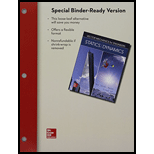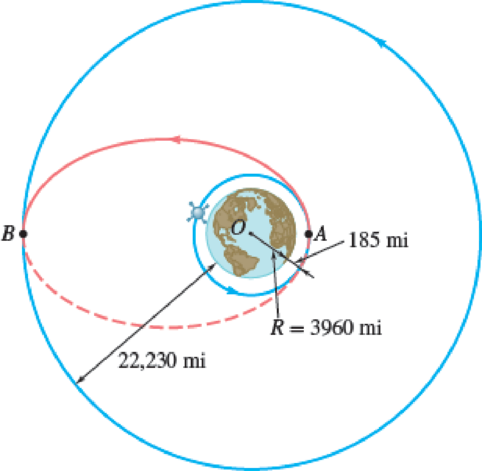
Concept explainers
While describing a circular orbit, 185 mi above the surface of the earth, a space shuttle ejects at point A an inertial upper stage (IUS) carrying a communications satellite to be placed in a geosynchronous orbit (see Prob. 13.87) at an altitude of 22,230 mi above the surface of the earth. Determine (a) the velocity of the IUS relative to the shuttle after its engine has been fired at A, (b) the increase in velocity required at B to place the satellite in its final orbit.
Fig. P13.101

(a)
Find the velocity of the IUS relative to the shuttle after its engine has been fired at A
Answer to Problem 13.101P
The velocity of the IUS relative to the shuttle after its engine has been fired at A
Explanation of Solution
Given information:
The distance from above the earth surface to the circular orbit (x) is
The altitude of the geosynchronous orbit (A) is
The radius of the earth (R) is
The acceleration due to gravity (g) is
Calculation:
Convert the unit of radius of earth (R) from miles to feet using the relation:
Here,
Substitute
Write the expression for the force acting on the spacecraft on the surface of the earth due to gravity
Write the expression for calculating the geocentric force acting on the spacecraft when it is on the surface of earth
Here, G is the universal gravitational constant, M is the mass of the earth and
Substitute
Substitute
Write the expression for the centripetal force acting on the space shuttle carrying satellite rotating around the earth at the given altitude as follows:
Here, m is the mass of the space shuttle,
Write the expression for the geocentric force acting on the spacecraft rotating at the given altitude around the earth (F) as follows;
Equate the equations (1) and (2).
Calculate the altitude of the space shuttle from center of earth at position A
Substitute
Calculate the velocity of space shuttle at point A inertial upper stage
Substitute
Calculate the altitude of the space shuttle from center of earth at position A
Substitute
Calculate the velocity of space shuttle at point B
Substitute
Use the principle of conservation of angular momentum states that in the absence of external torque acting on the body, the angular momentum remains constant and no change of the momentum occurs during the entire process.
Find the velocity at B:
Here,
Substitute
Write the expression for the kinetic energy of the space shuttle at point A
Write the expression for the kinetic energy of the space shuttle at point B
Write the expression for the gravitational potential energy of the space shuttle at position A in the path AB
Write the expression for the gravitational potential energy of the space shuttle at position B in the path AB
Use the principle of conservation of energy states that sum of the kinetic and potential energy of a particle remains constant.
Calculate the speed of the space shuttle at position A
Write the expression for the conservation of energy as follows:
Substitute
Find the velocity at A:
Substitute
Consider the equation (1).
Find the velocity at B:
Substitute
Calculate the velocity of the IUS relative to the shuttle after the engine has been fired at point A
Substitute
Therefore, the velocity of the IUS relative to the shuttle after its engine has been fired at A
(b)
Find the increase in velocity required at B
Answer to Problem 13.101P
The increase in velocity required at B
Explanation of Solution
Given information:
The distance from above the earth surface to the circular orbit (x) is
The altitude of the geosynchronous orbit (A) is
The radius of the earth (R) is
The acceleration due to gravity (g) is
Calculation:
Calculate the increase in the velocity required at B to place the satellite in its final orbit
Substitute
Therefore, the increase in velocity required at B
Want to see more full solutions like this?
Chapter 13 Solutions
VECTOR MECH...,STAT.+DYNA.(LL)-W/ACCESS
- Determine the moments of the force about the x and the a axes. O 4 m F = {-40i +20j + 10k} N 3 m 6 m aarrow_forward6. A part of the structure for a factory automation system is a beam that spans 30.0 in as shown in Figure P5-6. Loads are applied at two points, each 8.0 in from a support. The left load F₁ = 1800 lb remains constantly applied, while the right load F₂ = 1800 lb is applied and removed fre- quently as the machine cycles. Evaluate the beam at both B and C. A 8 in F₁ = 1800 lb 14 in F2 = 1800 lb 8 in D RA B C 4X2X1/4 Steel tube Beam cross section RDarrow_forward30. Repeat Problem 28, except using a shaft that is rotating and transmitting a torque of 150 N⚫m from the left bear- ing to the middle of the shaft. Also, there is a profile key- seat at the middle under the load.arrow_forward
- 28. The shaft shown in Figure P5-28 is supported by bear- ings at each end, which have bores of 20.0 mm. Design the shaft to carry the given load if it is steady and the shaft is stationary. Make the dimension a as large as pos- sible while keeping the stress safe. Determine the required d = 20mm D = ? R = ?| 5.4 kN d=20mm Length not to scale -a = ?- +а= a = ? + -125 mm- -250 mm- FIGURE P5-28 (Problems 28, 29, and 30)arrow_forward12. Compute the estimated actual endurance limit for SAE 4130 WQT 1300 steel bar with a rectangular cross sec- tion of 20.0 mm by 60 mm. It is to be machined and subjected to repeated and reversed bending stress. A reli- ability of 99% is desired.arrow_forward28. The shaft shown in Figure P5-28 is supported by bear- ings at each end, which have bores of 20.0 mm. Design the shaft to carry the given load if it is steady and the shaft is stationary. Make the dimension a as large as pos- sible while keeping the stress safe. Determine the required d = 20mm D = ? R = ?| 5.4 kN d=20mm Length not to scale -a = ?- +а= a = ? + -125 mm- -250 mm- FIGURE P5-28 (Problems 28, 29, and 30)arrow_forward
- 2. A strut in a space frame has a rectangular cross section of 10.0 mm by 30.0 mm. It sees a load that varies from a tensile force of 20.0 kN to a compressive force of 8.0 kN.arrow_forwardfind stress at Qarrow_forwardI had a theoretical question about attitude determination. In the attached images, I gave two axis and angles. The coefficient of the axes are the same and the angles are the same. The only difference is the vector basis. Lets say there is a rotation going from n hat to b hat. Then, you introduce a intermediate rotation s hat. So, I want to know if the DCM produced from both axis and angles will be the same or not. Does the vector basis affect the numerical value of the DCM? The DCM formula only cares about the coefficient of the axis and the angle. So, they should be the same right?arrow_forward
- 3-15. A small fixed tube is shaped in the form of a vertical helix of radius a and helix angle y, that is, the tube always makes an angle y with the horizontal. A particle of mass m slides down the tube under the action of gravity. If there is a coefficient of friction μ between the tube and the particle, what is the steady-state speed of the particle? Let y γ 30° and assume that µ < 1/√3.arrow_forwardThe plate is moving at 0.6 mm/s when the force applied to the plate is 4mN. If the surface area of the plate in contact with the liquid is 0.5 m^2, deterimine the approximate viscosity of the liquid, assuming that the velocity distribution is linear.arrow_forward3-9. Given that the force acting on a particle has the following components: Fx = −x + y, Fy = x − y + y², F₂ = 0. Solve for the potential energy V. -arrow_forward
 Elements Of ElectromagneticsMechanical EngineeringISBN:9780190698614Author:Sadiku, Matthew N. O.Publisher:Oxford University Press
Elements Of ElectromagneticsMechanical EngineeringISBN:9780190698614Author:Sadiku, Matthew N. O.Publisher:Oxford University Press Mechanics of Materials (10th Edition)Mechanical EngineeringISBN:9780134319650Author:Russell C. HibbelerPublisher:PEARSON
Mechanics of Materials (10th Edition)Mechanical EngineeringISBN:9780134319650Author:Russell C. HibbelerPublisher:PEARSON Thermodynamics: An Engineering ApproachMechanical EngineeringISBN:9781259822674Author:Yunus A. Cengel Dr., Michael A. BolesPublisher:McGraw-Hill Education
Thermodynamics: An Engineering ApproachMechanical EngineeringISBN:9781259822674Author:Yunus A. Cengel Dr., Michael A. BolesPublisher:McGraw-Hill Education Control Systems EngineeringMechanical EngineeringISBN:9781118170519Author:Norman S. NisePublisher:WILEY
Control Systems EngineeringMechanical EngineeringISBN:9781118170519Author:Norman S. NisePublisher:WILEY Mechanics of Materials (MindTap Course List)Mechanical EngineeringISBN:9781337093347Author:Barry J. Goodno, James M. GerePublisher:Cengage Learning
Mechanics of Materials (MindTap Course List)Mechanical EngineeringISBN:9781337093347Author:Barry J. Goodno, James M. GerePublisher:Cengage Learning Engineering Mechanics: StaticsMechanical EngineeringISBN:9781118807330Author:James L. Meriam, L. G. Kraige, J. N. BoltonPublisher:WILEY
Engineering Mechanics: StaticsMechanical EngineeringISBN:9781118807330Author:James L. Meriam, L. G. Kraige, J. N. BoltonPublisher:WILEY





